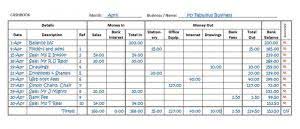
This is also true of the $20,000 of cash that was used to repay short-term debt and to purchase treasury stock for $2,000. On the other hand, the borrowing of $60,000 had a favorable or positive effect on the corporation’s cash balance. The net result of the four financing activities caused cash and cash equivalents to increase by $28,000. Cash outflows used to repay debt, to retire shares of stock, and/or to pay dividends to stockholders are unfavorable for the corporation’s cash balance. The third section of the statement of cash flows reports the cash received when the corporation borrowed money or issued securities such as stock and/or bonds.
Cash Flows from Operating Activities
The fluctuation of retained earnings is captured in the stockholder’s equity statement. As illustrated by this Home Depot statement, stockholders’ equity equals total paid-in capital plus retained earnings minus treasury stock. In a balance sheet, shareholder’s equity is the discrepancy between the total assets and total statement of shareholders equity example liabilities. It represents the net assets held by the owners or shareholders of the company.
Are you ready to take your business to the next level?
Individual or institutional investors review these aspects in detail when making their investment decisions, while company management also uses this as https://www.bookstime.com/ a tool for strategic planning and decision-making. As a result, a thorough understanding of these components and their implications is essential for anyone involved in or interested in the business. It will reveal whether you didn’t make enough to sustain operations or whether you have enough equity in the business to get through a downturn.
- But an important distinction is that the decline in equity value occurs due to the “book value of equity”, rather than the market value.
- These have not yet been distributed to stockholders and are being held by the corporation for future investment in the business.
- If a firm does not want to keep the shares for future financing, it can retire them.
- The Statement Of Shareholder Equity shows the value of a company after investors and stockholders have been paid out.
Stockholders’ Equity and Retained Earnings (RE)
The net income from operations and other business activities maintained by a firm as additional equity capital is referred to as retained earnings (RE). Companies use both equity and borrowed capital to support capital purchases. The equity capital/stockholders’ equity of a firm can also be defined as its net assets (total assets minus total liabilities).


The difference between the statement of owner’s equity and the cash flow statement (CFS) is that the former portrays the changes in a company’s equity over a period in more detail. Note that the company had several equity transactions during the year, and the retained earnings column corresponds to a statement of retained earnings. Companies may expand this presentation to include comparative data for multiple years.
Understanding Changes in Shareholders Equity
Fluctuations in shareholder’s equity imply changes in the shareholders’ wealth. Drawdowns might indicate the issuance of dividends or buy-back of shares, while a surge could be due to the company’s accumulation of profits. Lastly, if a company incurs a loss, it must be deducted from retained earnings. If the losses exceed the available retained earnings, it might eat into other areas of equity – this situation can lead to negative shareholders equity. These components collectively help to evaluate a company’s equity, allowing anyone to get an understanding of the company’s health and performance.

Benefits Of Statement Of Shareholders’ Equity
These roles underscore the statement’s importance in fostering good corporate governance practices. Studying annual changes in shareholders equity provides a broad outlook on the company’s financial position. It could also highlight long term trends and potential issues, such as persistent dwindling profits or increasing liabilities. Companies that pay dividends are effectively https://www.facebook.com/BooksTimeInc/ redistributing a portion of their earnings back to the shareholders. When dividends are paid out, they are deducted from the company’s retained earnings and therefore reduce equity.
A statement of shareholder equity can tell you how well you’re running your business.
- The value can be both positive and negative, depending on the number of assets the companies own and their liabilities.
- The $15,000 is a positive amount since the money received has a favorable effect on the corporation’s cash balance.
- The approach may apply to separate additional columns for other classes of preferred stock.
- However, the impact of these initiatives on shareholders’ equity is not entirely negative.
- First, the beginning equity is reported followed by any new investments from shareholders along with net income for the year.
- Common stock, paid-in capital, retained earnings, and treasury stock are all examples of stockholders’ equity.
Common stockholders have more rights in the corporation in terms of voting on company decisions, but they are last on the priority list when it comes to paying. In the event of liquidation, common stockholders will be paid first, followed by bondholders and preference shareholders. The statement of shareholders equity plays a significant role in corporate governance. Through this essential financial document, corporations uphold an important facet of good governance—transparency. Beyond mere trend analysis, financial ratios derived from the shareholders equity statement help evaluate the company’s financial soundness and efficiency. Secondly, these correlations aid in determining the return on shareholder investments.
Retained Earnings
If an organization’s return on equity is below its cost of equity, this indicates that it’s not rewarding its shareholders adequately for the risk they bear to invest their funds in the company. ROE illustrates how well a company generates earnings from the equity invested in it. A high or increasing ROE can suggest that the company uses equity finance effectively and creates good returns for its investors.
